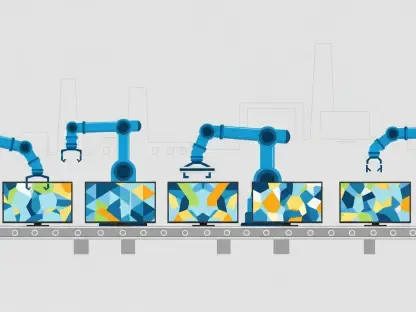In the fast-evolving realm of telecommunications, achieving seamless network automation remains a formidable challenge for service providers. Telenet, a prominent Belgian telecom company, has embarked on a pioneering journey to overcome these hurdles by embracing digital twin technology. This innovative approach integrates AI and advanced data analytics, mirroring the real-time operations of a physical network in a virtual environment. By doing so, Telenet has significantly enhanced its ability to predict, analyze, and resolve network issues. With ongoing collaboration with Celfocus and its parent company, Liberty Global, Telenet’s efforts revolve around creating an AI-ready network landscape tailored for future growth and scalability. The strategic deployment of digital twins forms a cornerstone of Telenet’s pursuit to break the automation glass ceiling, focusing on immediate adaptability and real-time decision-making capabilities.
Embracing the Network Digital Twin Technology
At the heart of Telenet’s transformational strategy lies the deployment of network digital twins—a virtual replication of physical network infrastructure. This technology not only facilitates comprehensive simulation of various network conditions but also empowers Telenet to perform predictive analytics, foreseeing potential issues before they manifest in the physical network. Digital twins serve as a testing ground for new innovations, allowing the company to experiment with various configurations and solutions in a risk-free environment. Through this, Telenet aims to establish a future-proof network platform adaptable to the ever-changing demands of the telecom industry. By leveraging digital twins, Telenet is advancing towards higher levels of network automation, taking strides to attain Level 4 autonomy.
This advancement aligns with Telenet’s vision for a more responsive, AI-integrated network, enabling more efficient resource allocation and service delivery. Embedded within this digital framework is a commitment to real-time adaptability, crucial for handling dynamic network demands and maintaining service excellence. This strategic focus emphasizes the importance of data management and quality—key elements in harnessing the full potential of digital twin technology. As such, Telenet’s endeavor involves not just technological adoption but also significant process refinement across its operations, ultimately paving the way for streamlined, efficient, and predictive network management.
Collaborative Efforts and Strategic Framework
The journey toward network automation and digital twin deployment is underscored by strong collaborative ties with strategic partners such as Celfocus and Liberty Global. These alliances are fundamental, providing vital expertise and technological support essential for the successful integration and implementation of advanced network solutions. The collaboration extends to aligning with frameworks like the TM Forum, ensuring that Telenet adheres to industry standards while pursuing its goals for greater network autonomy. By working in synergy with these partners, Telenet aims to transcend traditional operational boundaries, fostering a landscape conducive to innovation and enhanced service delivery.
Adopting a cross-domain, real-time decision-making approach is instrumental for Telenet to realize its ambitious automation objectives. The involvement of diverse domains ensures a holistic view of network operations, promoting cohesive decision-making and development. Workshops and cross-functional team engagements further reinforce this integrative approach, bringing together network architects, data scientists, and engineers to share insights and collaboratively design optimized network solutions. This framework supports the continuous evolution of Telenet’s network, emphasizing collaborative innovation as a path to overcoming existing limitations in telecommunications operations.
Data Foundations and AI Integration
In the pursuit of an AI-ready network, Telenet prioritizes the establishment of solid data foundations. The company is focused on dismantling data silos, ensuring seamless data flow across different operations, and enhancing the accessibility and quality of data available for analysis. By prioritizing data consumption and productization, Telenet sets the stage for AI and machine learning applications, enhancing predictive analytics and decision-making processes. This foundational work serves as a crucial precursor to the effective deployment of AI technologies across the network.
Moreover, the cognitive network operations layer introduced by Telenet exemplifies the role of AI in enabling real-time decision-making. This AI-driven layer enhances the ability to assess service impacts swiftly, drawing insights from cross-domain data sources. The integration of AI into network operations transforms the potential for automation, enabling more precise and efficient management of resources and unforeseen network challenges. Telenet’s emphasis on data quality and AI integration is revolutionary, underpinning a future where network operations are not only automated but intelligent and anticipatory in service delivery.
Fostering Trust and Skill Development
A critical component of Telenet’s success in network automation lies in fostering a culture of trust and continuous skill development among its workforce. The transition to digital twin technology and increased automation demands not just technological change but also a shift in expertise within teams. Telenet encourages its engineers to evolve into hybrid experts—professionals adept at integrating network knowledge with data-driven insights. This transformation is pivotal, as success metrics in network autonomy are increasingly dependent on the ability of personnel to adopt and adeptly use new technologies.
Building trust within teams also involves creating an environment where staff members are confident in the new systems and their abilities to use them effectively. Telenet’s investment in training and development programs has been substantial, cultivating the skills required for the successful adoption of digital twin and AI technologies. The outcome is a workforce better equipped to handle complex network scenarios and contribute actively to the company’s overarching goals in network management and innovation. This focus on human capital reflects Telenet’s holistic approach, understanding that the synthesis of technology and skilled personnel is key to sustainable automation progress.
Key Takeaways and Future Considerations
At the core of Telenet’s transformational strategy is the use of network digital twins—a virtual model of the physical network infrastructure. This innovative technology not only allows Telenet to simulate a wide range of network conditions but also equips them with the tools for predictive analytics. This means they’re able to identify and address potential issues before they actually occur in the real network. These digital twins create a safe space for testing new technologies and configurations without any risk, enabling Telenet to innovate and adapt to the telecom industry’s evolving demands seamlessly. By utilizing digital twins, Telenet is pushing towards a more automated network, aiming to reach Level 4 autonomy, characterized by fully autonomous network operations. This progress complements Telenet’s vision of an AI-driven network that efficiently allocates resources and delivers services. Their strategy underscores the importance of data management and quality, pivotal for maximizing the benefits of digital twin technology. Overall, Telenet is not just incorporating new tech; it is refining its processes for better, predictive network management.









